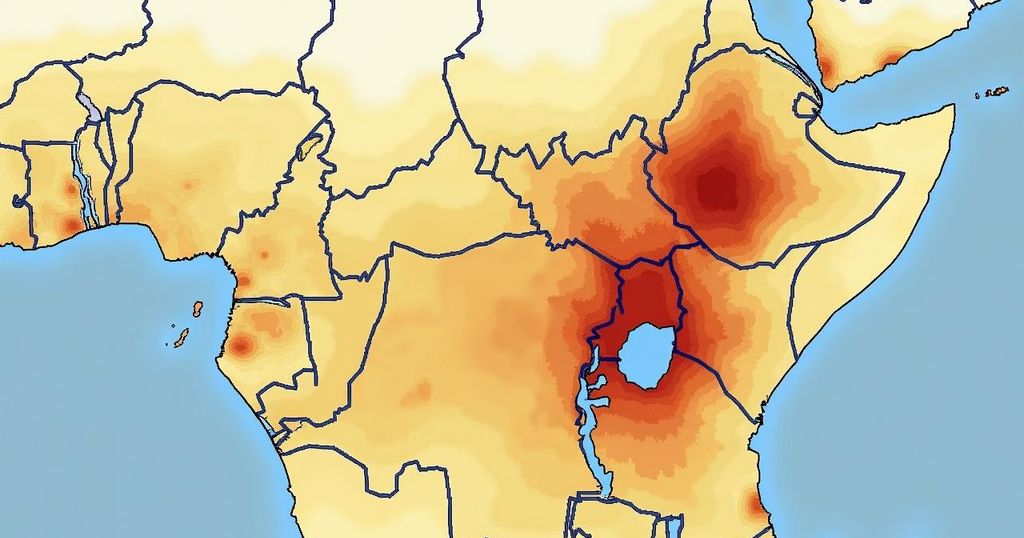The 2023/2024 El Niño event has precipitated a severe drought in Southern Africa, causing significant food insecurity, water scarcity, and public health risks. Nearly 23 million individuals are highly food insecure, with over 2 million children facing malnutrition. Six countries have declared national drought disasters, and the compounded effects of this crisis, alongside ongoing cholera outbreaks, pose significant challenges to local health systems.
The severe drought conditions affecting Southern Africa, driven by the 2023/2024 El Niño event, have created a humanitarian crisis characterized by a late onset of seasonal rains, prolonged dry spells, and rising temperatures. This current El Niño phenomenon is acknowledged as the most severe experienced in the last four decades, exacerbating the already precarious circumstances faced by communities due to failed agricultural yields and worsening economic conditions. Notably, the impact has manifested in drought-related food shortages, compromised access to clean water, outbreaks of disease, and significant livestock losses. The drought has resulted in historically low maize production figures, markedly below the five-year averages reported by national governments and FEWS NET estimates. Tragically, many communities have exhausted their limited food stocks, with several months left before the anticipated next harvest in April 2025. Currently, it is estimated that nearly 23 million individuals are experiencing critical food insecurity, with Malawi, Zambia, Zimbabwe, and Mozambique among the most severely impacted. Furthermore, FEWS NET forecasts that between 14.0 and 14.9 million people will urgently require humanitarian assistance during the critical October to December 2024 lean season. National declarations of drought disasters have been issued in six countries within the region, including Botswana, Lesotho, Malawi, Namibia, Zambia, and Zimbabwe, with Angola and Mozambique also suffering significant levels of food insecurity affecting approximately 1.8 million and 3.3 million people, respectively. In the context of ongoing food security crises, the number of acutely malnourished children is predicted to exceed 2 million in 2024, with over 500,000 affected by severe acute malnutrition. The adverse effects of these climatic changes are further compounded by displacement of populations, disease outbreaks, and the deterioration of water resources, which, when combined with preexisting vulnerabilities, pose severe threats to public health. Countries such as Malawi and Mozambique, already grappling with a cholera epidemic, exhibit a heightened risk for further outbreaks due to compromised hygiene resulting from water shortages. Additionally, the escalating challenges posed by the drought are likely to increase rates of HIV and AIDS transmission, exacerbate mental health issues, and enhance incidents of gender-based violence. These factors elucidate the pressing need for enhanced preparedness and response strategies. The combined challenges of El Niño impacts, cholera incidences, conflict, and climate change have significantly hindered health systems across Southern Africa, obstructing access to essential sexual and reproductive health services. Over one million individuals have been internally displaced due to climate-induced disasters, primarily originating from Malawi, Mozambique, and Zimbabwe.
The recurrent climate phenomenon known as El Niño has historically impacted Southern Africa’s weather patterns, resulting in severe drought and floods. The 2023/2024 event is notably severe, considered the worst in 40 years, leading to a variety of adverse socio-economic and public health challenges. Poor agricultural performance, food shortages, and water scarcity have heightened public health risks, particularly in malnourished communities already vulnerable to outbreaks of diseases. The compounded effects of climate change and disease epidemics, particularly cholera and measles, underscore the necessity for immediate humanitarian response efforts, especially for the most affected populations in southern African countries.
In summary, the ongoing drought conditions in Southern Africa caused by the unprecedented 2023/2024 El Niño event have led to severe humanitarian crises characterized by widespread food insecurity, health risks, and economic distress. The need for urgent humanitarian assistance is paramount, with millions facing acute malnutrition and water scarcity serving as a prelude to potentially devastating health threats. Snapshot assessments indicate that without immediate action, the situation risks spiraling further, necessitating regional and international support to mitigate the ongoing and future impacts of this climatic disaster.
Original Source: reliefweb.int






